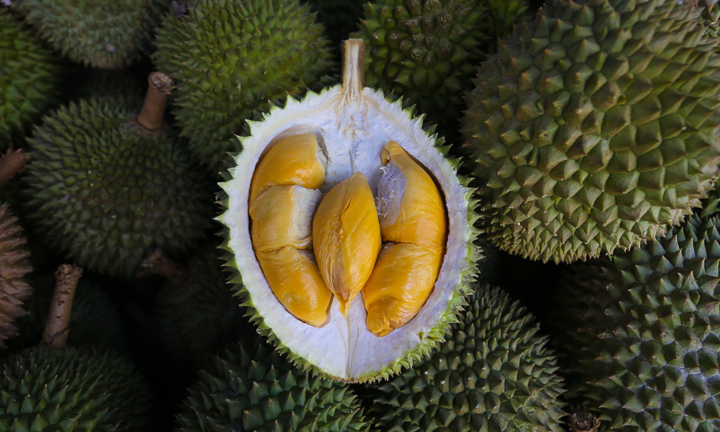SOURCE: Ida Lim, Malay Mail
Coconut was what Malaysians ate the most in terms of weight in 2020 out of 14 fruits included in an official study, with the second being durians.
In the Department of Statistics Malaysia’s (DOSM) report released today, the per capita consumption or the yearly individual consumption of Malaysia’s population in 2020 for coconut was the highest at 24.3kg for the entire year.
For the entire population of Malaysia they had collectively consumed coconuts weighing a total of 790,708,000kg or 790 million kg or 790,708 tonnes in 2020. The per capita consumption was calculated by dividing this total weight with the total population in the country.
Coconuts had kept this pole position out of the 14 fruits for the past four years as well, with per capita consumption of 17kg in 2016, 19.4 kg (2017), 21.4kg (2018) and 22.7kg (2019).
The steadily increasing trend was recorded as Malaysia’s population too increased over the years, from 31.63 million (2016), 32.02 million (2017), 32.38 million (2018), 32.52 million (2019), 32.58 million (2020). Such population figures include non-citizens typically in the past few years numbering more than three million.
As for durians, which is popularly known as the King of Fruits, the per capita consumption by the Malaysia population was at 11.1kg in 2020. This made it the second highest consumed fruit in 2020 in terms of weight in the DOSM report.
The entire population in Malaysia would have collectively consumed 303,651,700kg or 303 million kg of durians in 2020. Or in other words, 303,651.7 tonnes.
For the other years, the per capita consumption in Malaysia for durians was 9.1kg per year (2016), 6.4 (2017), 9.8 (2018) and 10.7 (2019).
For 2020, the next highest per capita consumption in Malaysia for the fruits included in the report was banana (9kg per year), pineapple (7.2), watermelon (2.8), mango (1.8), sweet corn (1.7), jackfruit (1.6), rambutan (1.4), papaya (1.1), guava (1.1), mangosteen (0.7), langsat (0.5), and finally starfruit (0.2).
Top fruits exported out by Malaysia, by weight
While Malaysia’s durians are well sought after abroad, it is not the fruit that is the top in exports in terms of weight in 2020.
In 2020, watermelons recorded the highest exports out of Malaysia in terms of weight out of the 14 fruits studied, with 45,324.3 tonnes or 45,324,300 kg or 45 million kg sent out.
This was followed by bananas where 28,059.3 tonnes were exported in 2020, and durians with 24,098.9 tonnes exported, papayas (22,487.2 tonnes), pineapple (15,960.6 tonnes).
Exports in 2020 of the other fruits in the report were in the thousands of tonnes, namely sweet corn (6,882.6), jackfruit (5,649.8), coconut (4,659.2), mango (4,076.0), guava (2,916.2), mangosteen (2,309.9), starfruit (1,373.2), while the rest were considerably lesser in terms of weight — rambutan (767.7) and langsat (540.8).
Out of the 14 fruits, eight of them had a self-sufficiency ratio (SSR) of more than 100 per cent in 2020, which means Malaysia produced more than enough of these fruits for local needs.
The eight fruits are papaya with the highest SSR at 156 per cent, watermelon (139.4 per cent), starfruit (117.3 per cent), jackfruit (109.9 per cent), sweet corn (105.6 per cent), durian (105.2 per cent), pineapple (104.7 per cent) and banana (100.1 per cent).
The SSR for other fruits in 2020 were rambutan (98.1 per cent), guava (96.9), langsat (96.9), mangosteen (93.1), and coconut (66.6).
The fruit with the lowest SSR in 2020 is mango at 20.2 per cent, which meant that Malaysia was highly dependent on imports to meet local demand for mango.
This was shown with the import dependency ratio (IDR) for mango being the highest in 2020 at 86.2 per cent. In fact, this fruit had the highest IDR for the past four years consecutively, at levels above 70 per cent or above 80 per cent in 2016 to 2019.
The next highest IDR in 2020 was for coconut at 34 per cent, followed by mangosteen (16.1), guava (10.6), banana (8.9), watermelon (7.7), langsat (6.4), sweet corn (5.1), while the rest were all below five per cent.
The DOSM report was titled “Supply and Utilization Accounts Selected Agricultural Commodities, Malaysia 2016-2020”, and looked into statistics related to 45 selected agricultural commodities.

